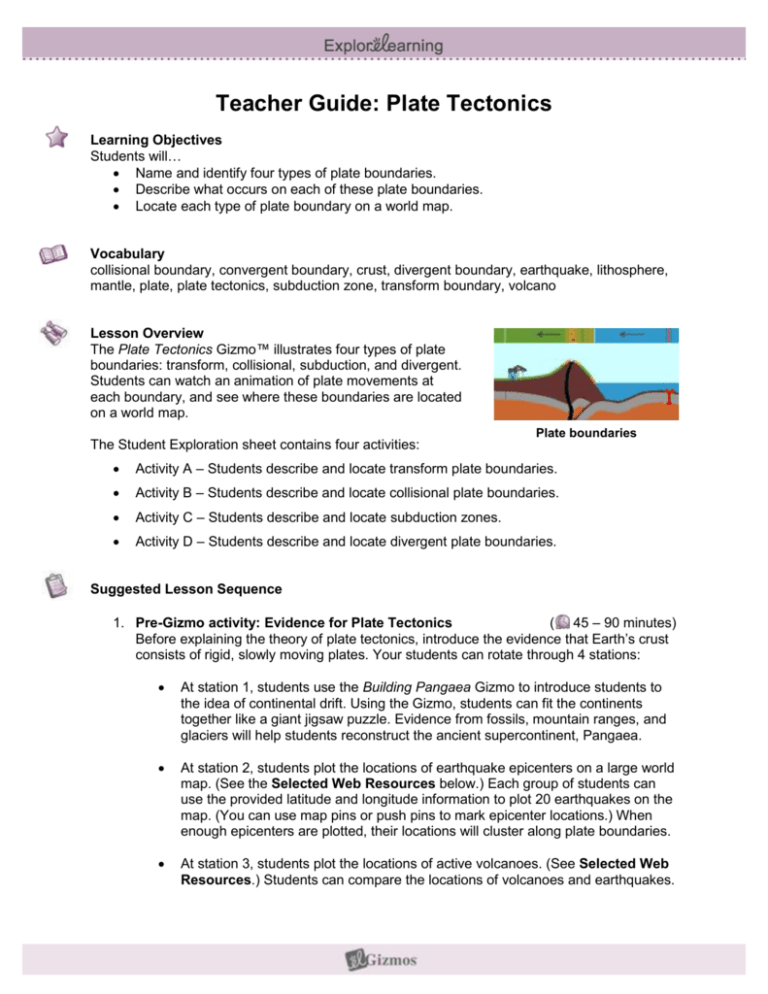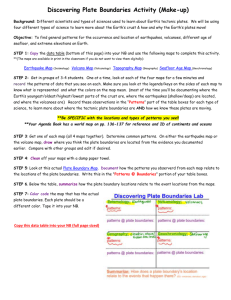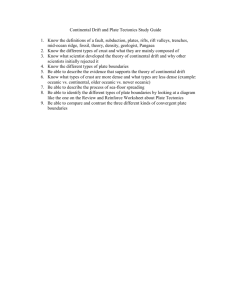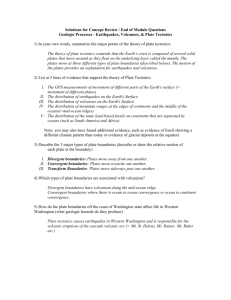File
advertisement

Teacher Guide: Plate Tectonics Learning Objectives Students will… Name and identify four types of plate boundaries. Describe what occurs on each of these plate boundaries. Locate each type of plate boundary on a world map. Vocabulary collisional boundary, convergent boundary, crust, divergent boundary, earthquake, lithosphere, mantle, plate, plate tectonics, subduction zone, transform boundary, volcano Lesson Overview The Plate Tectonics Gizmo™ illustrates four types of plate boundaries: transform, collisional, subduction, and divergent. Students can watch an animation of plate movements at each boundary, and see where these boundaries are located on a world map. The Student Exploration sheet contains four activities: Plate boundaries Activity A – Students describe and locate transform plate boundaries. Activity B – Students describe and locate collisional plate boundaries. Activity C – Students describe and locate subduction zones. Activity D – Students describe and locate divergent plate boundaries. Suggested Lesson Sequence 1. Pre-Gizmo activity: Evidence for Plate Tectonics ( 45 – 90 minutes) Before explaining the theory of plate tectonics, introduce the evidence that Earth’s crust consists of rigid, slowly moving plates. Your students can rotate through 4 stations: At station 1, students use the Building Pangaea Gizmo to introduce students to the idea of continental drift. Using the Gizmo, students can fit the continents together like a giant jigsaw puzzle. Evidence from fossils, mountain ranges, and glaciers will help students reconstruct the ancient supercontinent, Pangaea. At station 2, students plot the locations of earthquake epicenters on a large world map. (See the Selected Web Resources below.) Each group of students can use the provided latitude and longitude information to plot 20 earthquakes on the map. (You can use map pins or push pins to mark epicenter locations.) When enough epicenters are plotted, their locations will cluster along plate boundaries. At station 3, students plot the locations of active volcanoes. (See Selected Web Resources.) Students can compare the locations of volcanoes and earthquakes. At station 4, show students a map of the ages of rocks on the ocean floor. (See Selected Web Resources.) Ask students: What is going on? Why is young rock found along the middle of the ocean basin, while the older rock is at the edges? After students have visited the stations, ask them about what they have seen. Can anyone come up with a single theory to explain all of the patterns they have found? 2. Prior to using the Gizmo ( 10 – 15 minutes) Before students are at the computers, pass out the Student Exploration sheets and ask students to complete the Prior Knowledge Questions. Discuss student answers as a class, but do not provide correct answers at this point. Afterwards, if possible, use a projector to introduce the Gizmo and demonstrate its basic operations. Demonstrate how to take a screenshot and paste the image into a blank document. 3. Gizmo activities ( 15 – 20 minutes per activity) Assign students to computers. Students can work individually or in small groups. Ask students to work through the activities in the Student Exploration using the Gizmo. Alternatively, you can use a projector and do the Exploration as a teacher-led activity. 4. Discussion questions ( 15 – 30 minutes) As students are working or just after they are done, discuss the following questions: California is famous for earthquakes. Why are there so many earthquakes in California? The world’s tallest mountains, the Himalayas, are located on the boundary between the Indian plate and the Eurasian plate. What caused them to form? Which do you think is denser, oceanic crust or continental crust? Explain. The Pacific Ocean is surrounded by a “ring of fire,” a region of active volcanoes in New Zealand, Indonesia, the Philippines, Japan, and the west coasts of North and South America. Why are there so many volcanoes in these areas? Crust is destroyed along convergent boundaries. Where is crust produced? Is the Atlantic Ocean growing or shrinking? Iceland is located right on the border of the North American Plate and the Eurasian Plate. What would you expect to find in Iceland? [Iceland contains active volcanoes, geysers, hot springs, and a rift valley.] 5. Follow-up activity: Magnetic stripes ( 30 – 45 minutes) As liquid magma cools to form new rock, tiny iron crystals align with Earth’s magnetic field before being frozen in place. In the 1960’s, scientists used sensitive instruments to measure these magnetic orientations preserved in rocks on the seafloor. Surprisingly, the rocks showed a history of magnetic reversals; times when Earth’s north and south magnetic poles switched places. The magnetic reversals formed a pattern of “stripes” that were arranged symmetrically on either side of a mid-ocean ridge (dashed line at right). The symmetry demonstrated that the seafloor was spreading away from the ridge. Magnetic stripes To model seafloor spreading, first draw dark horizontal stripes across a sheet of white printer paper (figure A). The stripes represent the magnetic orientation of the ocean crust. Fold the paper in half lengthwise, and cut along the fold. Next, cut three slits in a sheet of construction paper as shown in figure B. Push the two paper halves through the middle slit (stripes on the inside), and then pull them apart so that each strip of paper goes through one of the side slits (figure C). Slowly pull the papers to show the creation of new ocean crust in the divergent boundary at the center and the destruction of ocean crust in the convergent boundaries at the sides. At any given time, the pattern of stripes will be symmetrical. Scientific Background The theory of plate tectonics states that Earth’s crust and lithosphere are divided up into rigid, slowly moving pieces called tectonic plates. There are eight major plates (Eurasian, Pacific, North American, South American, African, Indian, Australian, and Antarctic) and many minor plates (Nazca, Cocos, Philippine, Arabian, Caribbean, and others). Plates meet at plate boundaries. At transform boundaries, the two plates slide past each other horizontally. Transform boundaries are associated with faults and earthquakes. At convergent boundaries, plates move together. There are two types of convergent boundaries. Collisional boundaries occur where two plates bearing continental crust are colliding. Collisional boundaries, such as the boundary between India and Eurasia, are associated with large mountains and earthquakes. Subduction zones occur where dense oceanic crust moves under, or is subducted, below less-dense crust. Subduction zones are associated with island chains, ocean trenches, earthquakes, mountain ranges, and volcanoes. Divergent boundaries are places where plates move apart and new crust is formed. Most divergent boundaries occur along mid-ocean ridges. Many mid-ocean ridges are home to communities of unique organisms that use the heat of deep-sea vents as a source of energy rather than sunlight. Selected Web Resources Recent earthquakes: http://earthquake.usgs.gov/eqcenter/recenteqsww/Quakes/quakes_all.html Volcanoes: http://www.ssec.wisc.edu/data/volcano.html, http://www.volcano.si.edu/reports/usgs/ Physical map of the world: http://www.nacis.org/data/world_map/map2_base.jpg Age of ocean floor: http://www.ucmp.berkeley.edu/tectonics/crustages.jpg Plate tectonics: http://abyss.uoregon.edu/~js/lectures/age_of_the_earth/age_of_the_earth.html Seafloor spreading activity: http://www.ucmp.berkeley.edu/fosrec/Metzger3.html Plate tectonics activity: http://www.beloit.edu/sepm/Earth_Works/Sea_floor_spreading.html Discovering plate boundaries: http://terra.rice.edu/plateboundary/intro.html Seafloor spreading: http://pubs.usgs.gov/of/1999/ofr-99-0132/ Related Gizmo: Building Pangaea: http://www.explorelearning.com/gizmo/id?633







